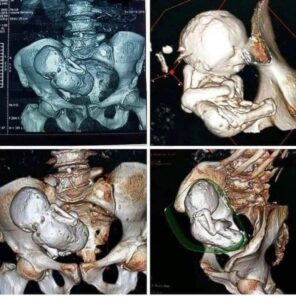Certainly! Here’s a full article on the rare medical case of a calcified fetus (lithopedion):
The Stone Baby: Doctors Discover 30-Year-Old Calcified Fetus in 73-Year-Old Woman
In a rare and remarkable medical case that has captured global attention, doctors discovered a 30-year-old calcified fetus inside the abdomen of a 73-year-old woman. The case, revealed through a CT scan, highlights one of the most unusual and mysterious phenomena in medicine—lithopedion, or “stone baby.”
What Is a Lithopedion?

The term lithopedion comes from the Greek words “lithos” meaning stone and “paidion” meaning child. It refers to an extremely rare condition in which a fetus dies during an ectopic or abdominal pregnancy and is not reabsorbed by the mother’s body. Instead, to protect itself from infection, the mother’s body encapsulates the fetal remains in layers of calcium, effectively mummifying and preserving the fetus in a calcified state.
This usually occurs when fetal death happens in the second trimester or later, and the pregnancy is abdominal rather than within the uterus. The body, failing to recognize or respond to the fetal demise, leaves the fetus in place. Over time, calcium builds up around the tissue, turning the fetus into a calcified mass.
A Medical Mystery Hidden for Decades
In this recent case, the 73-year-old woman had no idea that she had been carrying the remains of a fetus for more than three decades. She had no symptoms or awareness of the condition until she underwent medical imaging for an unrelated issue. The CT scan revealed the shocking presence of the calcified fetus, which had remained hidden and asymptomatic all those years.
Medical experts say that fewer than 400 cases of lithopedion have been documented in recorded history. Most of them are discovered incidentally—often during scans for unrelated medical conditions or during surgeries.
How Does It Go Undetected?
The human body has a remarkable ability to adapt and protect itself. In the case of a lithopedion, the calcification process effectively seals off the fetus from the rest of the body, preventing infection or inflammation. Because the process is slow and internal, it may cause no significant pain or warning signs, allowing the condition to go unnoticed for decades.
In many regions, particularly those with limited access to prenatal care or diagnostic imaging, such cases may never be diagnosed at all unless symptoms develop or imaging is performed.
A Glimpse into the Unseen
This case serves as a powerful reminder of how the human body can harbor secrets for years—even decades—and underscores the importance of medical imaging in revealing hidden conditions. While lithopedion is extraordinarily rare, it remains one of the most fascinating examples of the body’s self-preserving capabilities in the face of tragedy.
As medical technology continues to advance, more of these hidden stories are coming to light, offering insight into conditions once thought to be the stuff of legend.
Would you like a title image, infographic, or social media version of this article?





